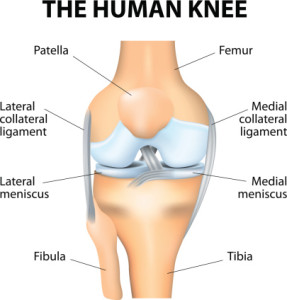
ACL Injury and Female Athletes
Anterior cruciate ligament (ACL) injuries are one of the most common knee injuries in sports.
The majority of ACL injuries (at least 70%) are non-contact in nature. The most common causes of non-contact ACL injury include:
- Change of direction or cutting maneuvers
- Deceleration
- Landing awkwardly from a jump
- Pivoting with the foot planted on the ground

Human Knee Anatomy
Female athletes have been identified as having a 2 to 8 times higher incidence of ACL injury than male athletes participating in the same sports, making ACL injury and female athletes an epidemic. This greater risk of ACL injury, as well as increased female participation in sports throughout the years, has led to a significant rise in ACL injuries in female athletes overall.
More than 50,000 debilitating ACL injuries occur in female athletes at the high school and intercollegiate varsity levels in an average year. As many as 1 in 20 collegiate level and 1 in 50-100 high school level female athletes sustain an ACL injury during any given year. Identification of risk factors associated with ACL injury mechanism may provide direction for targeted preventative treatment to high-risk individuals.
Prevention is a crucial step in the management of ACL injuries. Anterior cruciate ligament disruptions are a detriment to both the physical and psychological wellbeing of the athlete. More than 50% of patients show early signs of osteoarthritis within 10 years of ACL reconstruction, particularly in females. This is in addition to the traumatic effect of potential losses of entire seasons of sports participation, scholarship funding, and potential decreased performance in the academic arena.
Several theories have been proposed to explain the mechanisms underlying the gender difference in anterior cruciate ligament injury rates. These theories include both the intrinsic and extrinsic variables.
Intrinsic gender differences include:
- Anatomy
- Hormones
- Neuromuscular imbalance
- Biomechanics
The specific neuromuscular and biomechanical imbalances that have been identified in females that may put them at greater risk of ACL injury than males include:
Neuromuscular
- Ligament dominance
- Increased load on the knee joint
- Quadriceps dominance
- Decreased hamstring recruitment and strength
- Leg dominance
- Increased leg-to-leg differences in muscle coordination and strength
- Trunk dominance
- Increased motion of the body’s center of mass
Biomechanical
- During jumping/landing movements
- Increase in dynamic lower extremity valgus
- Increase in knee abduction loading
- Higher ground reaction forces
These imbalances lead to decreased dynamic knee stability in females and contribute to the gender bias in ACL injury risk. However, neuromuscular training has been shown to be effective in the reduction of ACL injury risk in females.
A prophylactic training program that focuses on developing neuromuscular control of the lower extremity through strengthening exercises, plyometrics, and sports-specific agility may address the proprioceptive and biomechanical deficits that are demonstrated in the high-risk female athletic population.
Please contact Physical Solutions today if you would like to arrange such a program one-on-one for your athlete. We also offer group programs for teams and schools.
References:
Hewett TE, Myer GD, Ford, KR. Anterior Cruciate Ligament Injuries in Female Athletes Part 1, Mechanisms and Risk Factors. Am J Sports Med. 2006; 34(2):299-311.
Hewett TE, Ford KR, Myer GD. Anterior cruciate ligament injuries in female athletes: Part 2, a meta-analysis of neuromuscular interventions aimed at injury prevention. Am J Sports Med. 2006; 34(3):490-498.
Hewett TE, et al. The Effect of Neuromuscular Training on the Incidence of Knee Injury in Female Athletes: a Prospective Study. Am J Sports Med. 1999; 27; 699-706.
Hewett TE, Johnson DL. ACL Prevention Programs: Fact or Fiction? Orthopedics.2010; 33(1).
Ireland ML. Anterior Cruciate Ligament Injury in Female Athletes: Epidemiology. Journal of Athletic Training. 1999; 34(2): 150-154.
LaBella CR, Hennrikus W, Hewett TE. Clinical Report: Anterior Cruciate Ligament Injuries: Diagnosis,
Treatment, and Prevention. Pediatrics. 2014; 133(5): 1437-1450.
Mandelbaum BR, et al. Effectiveness of a Neuromuscular and Proprioceptive Training Program in Preventing Anterior Cruciate Ligament Injuries in Female Athletes 2-Year Follow-up. Am J Sports Med. 2005; 33:1003-1010
Renstrom P, et al. Non-contact ACL injuries in female athletes: an International Olympic Committee current concepts statement. Br J Sports Med. 2008 Jun; 42(6): 394–412.
